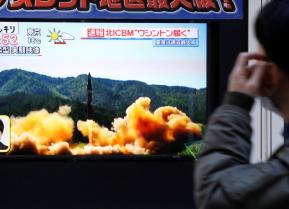Russia's Next Deadly Weapon: A Stealth, Jet-Powered Robot Warplane
Okhotnik-B could see squadron service.
Russia is developing a stealthy, jet-powered robot warplane. In contrast to the Kremlin's previous, abortive effort to field a killer drone, this latest effort appears likely to produce a useful, front-line aircraft.
The first blurry images of the Okhotnik-B drone appeared on Jan. 23, 2019 on a Russian aviation website. The photos depict a tractor towing the apparently roughly 50-foot-wide unmanned aerial vehicle along a snow-ringed runway at an airfield in Novosibirsk in southern Russia.
A flying wing similar in shape to the U.S. Air Force's B-2 stealth bomber, Okhotnik-B—that means "hunter" in Russian—in theory could penetrate enemy defenses to deliver ordnance.
Okhotnik is in the same class as China's Tian Ying drone, the U.S. Air Force's RQ-170 surveillance unmanned aerial vehicle, the U.S. Navy's experimental X-47B UAV and Boeing's X-45C drone demonstrator.
The likelihood of Okhotnik eventually entering squadron service with the Russian air force is "big," Tom Cooper, an independent expert on Russian military aviation, told The National Interest.
"The Russian military is running multiple UAV-related projects," Cooper said. "Thus the emergence of this project is perfectly normal."
Cooper said that, for the Russians, Okhotnik is "simply the further development of what they’ve been doing until now."
That wasn't always the case. In 2007 Russian warplane-maker Mikoyan and Gurevich revealed its Skat UAV prototype, which like Okhotnik was a jet-powered flying wing with potential stealth qualities.
But with the Russian economy struggling and military spending flat, the Skat went nowhere. It took a decade, big boosts in the Kremlin's budget and painful experience in Syria for Russian UAV programs to begin producing aircraft with any chance of actually reaching squadrons.
In late 2018 the Kremlin gave drone programs a big boost, Samuel Bendett, an expert on the Russian military, told reporter Kelsey Atherton.
Mid-December 2018 "marked a series of key announcements from the Russian ministry of defense about the country’s growing unmanned aerial systems capabilities," Bendett said. "Going into Syria in 2015, Russia was lacking a key combat element — the ability to hit targets quickly following their identification, one of the key functions of [unmanned combat air vehicles] around the world today."
"Moscow’s experience in Syria underscored that point — despite fielding a large number of [intelligence, surveillance and reconnaissance] drones that enabled Russian to be more precise in combat, the majority of targets were hit by manned aviation or manned artillery forces," Bendett added. "Hence, the push today to field an entire lineup of strike UAVs for a diverse range of missions."
"Public statements by the Russian government and the military establishment also highlight the importance of unmanned systems for the country’s military and its ability to wage war. Just recently, President Putin stated key propriety areas for his military in 2019 — among them was an emphasis on unmanned and robotic systems development."
In addition to Okhotnik, the portfolio of Russian drone programs now includes the Forpost medium-endurance drone similar to the U.S. military's own Reaper drone. "The only thing they haven’t got by now would be recce UAVs with endurance of 12 to 24 hours," Cooper noted. "They were badly missing these in Syria of the last three years."
The Kremlin is developing a long-range ISR drone. But the Altius program has struggled. "Delays in production, a lack of key expertise and hi-tech components meant the entire scheduled pushed to the right by many years," Bendett explained.
Okhotnik might fare better. For 2019 "the Russian defense establishment is promising a test that will include a short-duration 'jump'—the UCAV will rise ever so briefly above the tarmac to test its launching and landing capabilities," Bendett said.
"At this point, it is going to be heaviest and fastest UAV [in Russian service] if and when fielded, but additional testing and evaluation will have to take place in order for this unmanned system to be fully functional. Its speed [up to 620 miles per hour] and weight — up to 20 tons — means that a host of aerodynamic, electronic and high-tech issues need to be worked out."
To be effective in service, Okhotnik will need small precision-guided munitions, too, Cooper pointed out. The Kremlin long has lagged behind the rest of the word in PGM development.
Okhotnik might need several more years of development before it's ready for squadron service. But Russian crews are already getting ready, Cooper said. "The first generation of pilots and ground crews for UAVs just completed their four-years-long training, and they meanwhile have plenty of experience in operating smaller UAVs in Syria."
David Axe serves as the new Defense Editor of the National Interest. He is the author of the graphic novels War Fix, War Is Boring and Machete Squad.
Image: YouTube Screenshot.


